



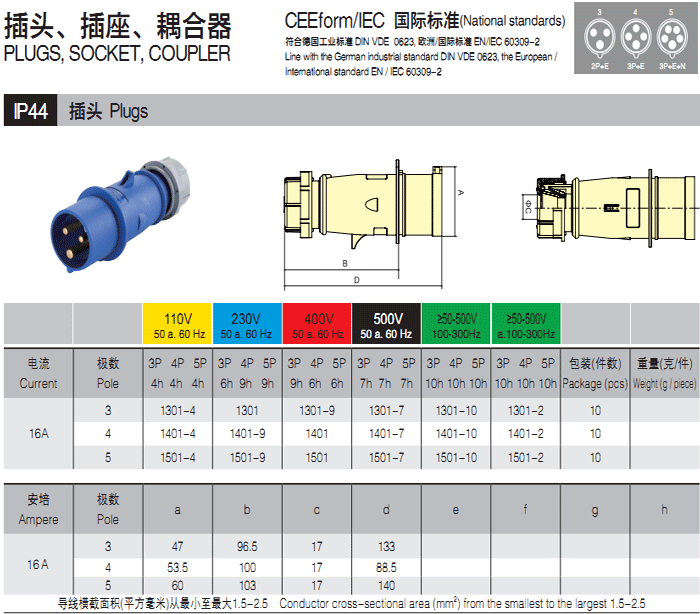
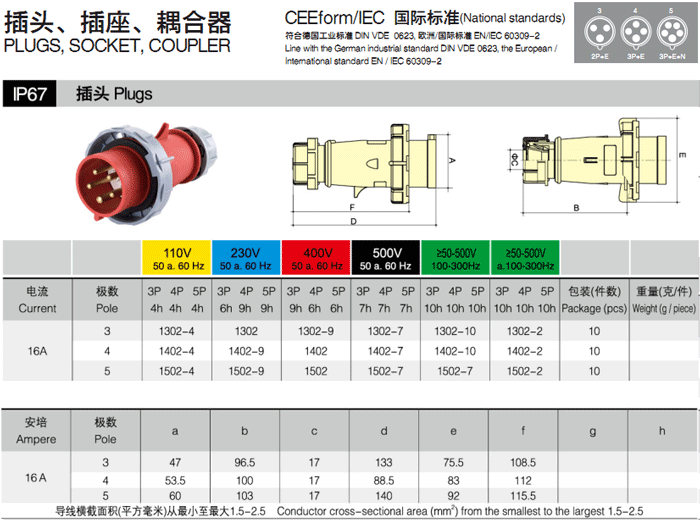
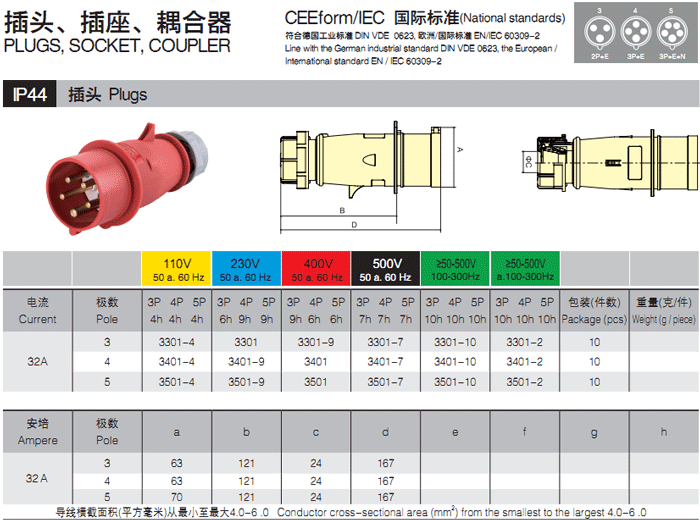
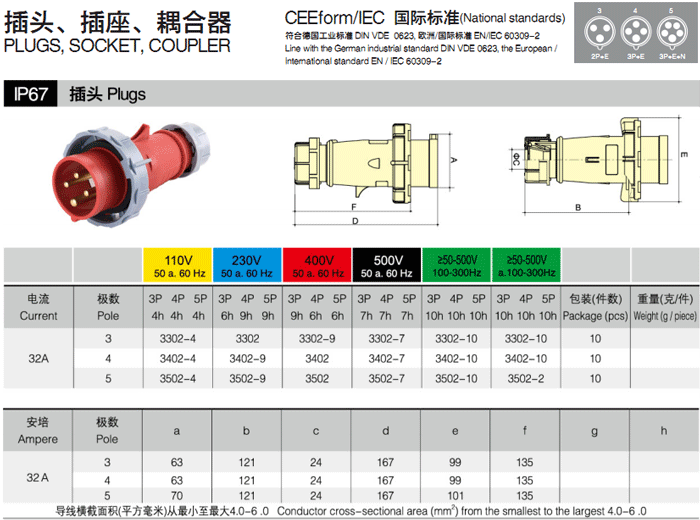
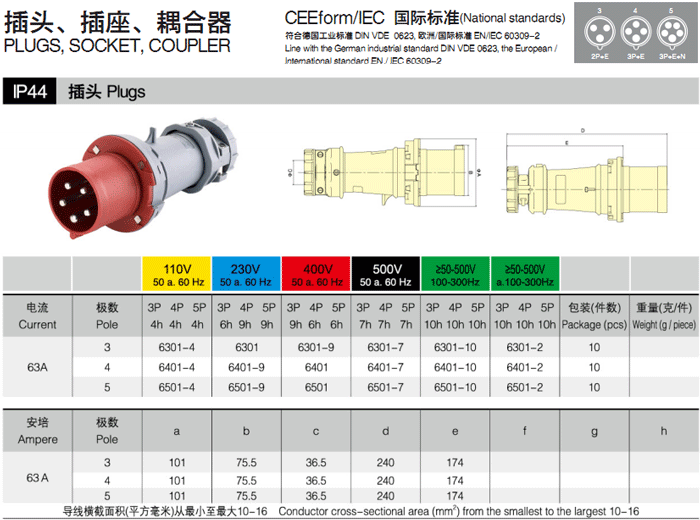
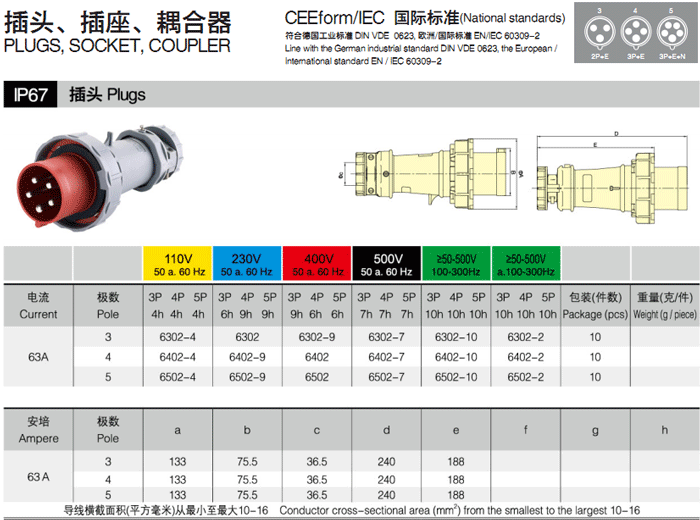
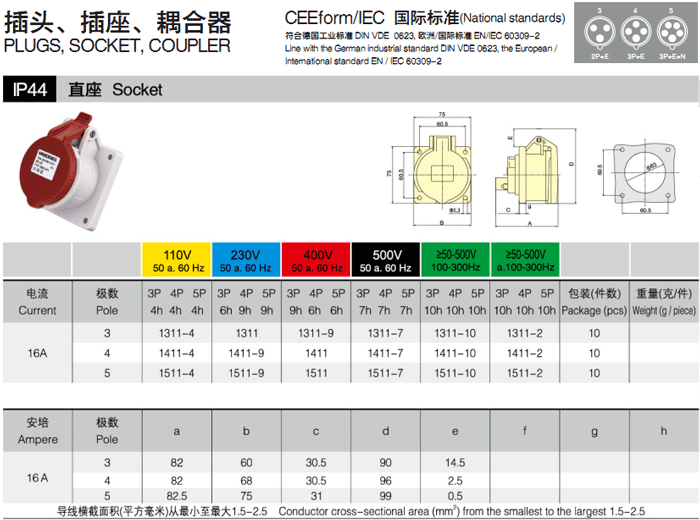
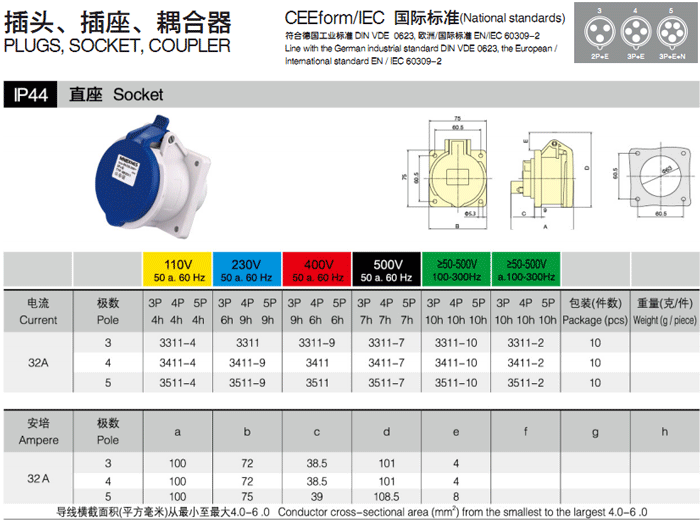
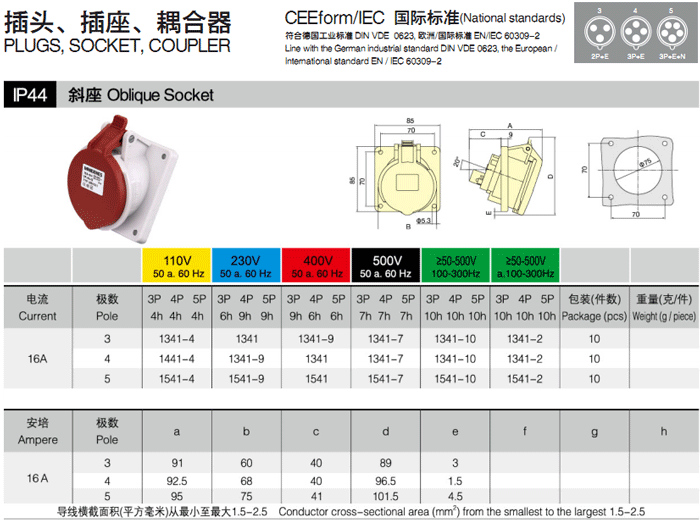
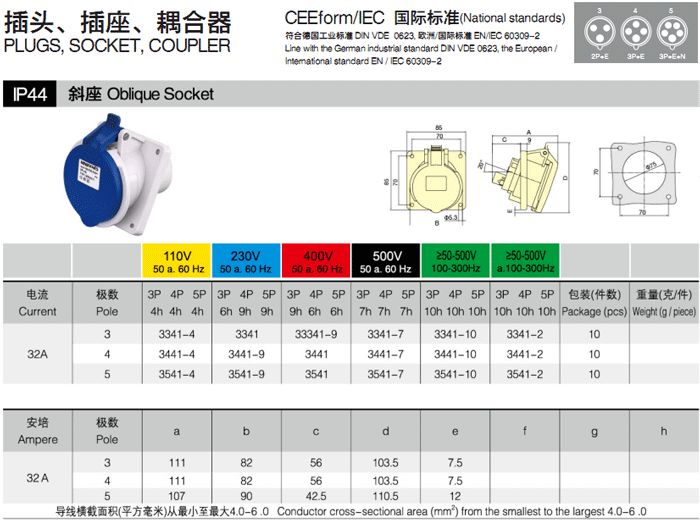
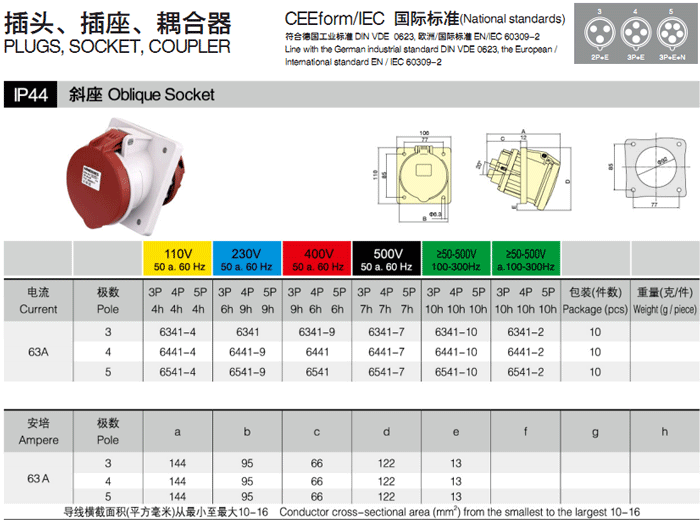
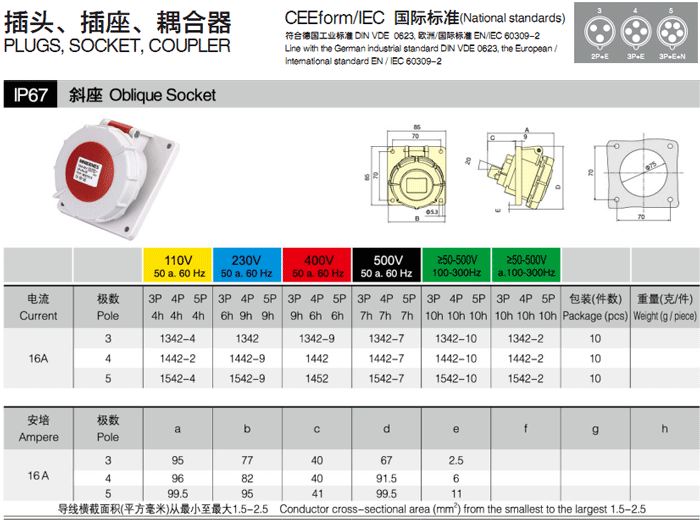
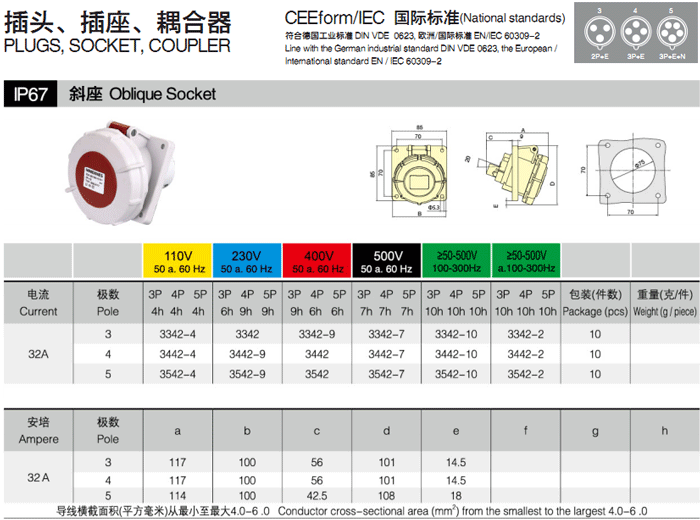
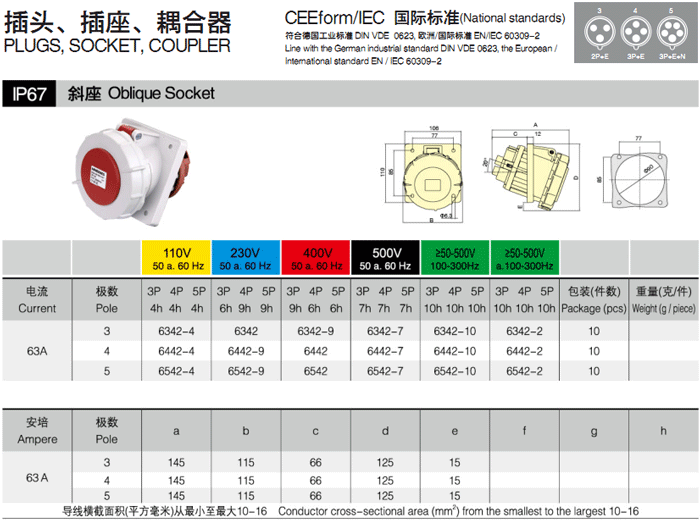
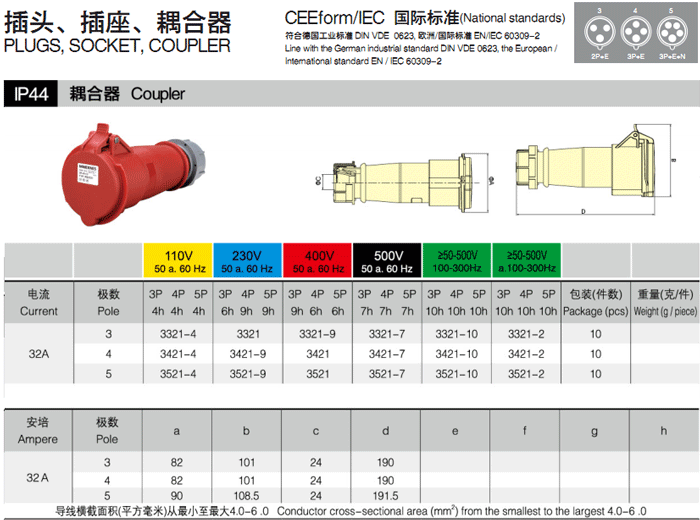
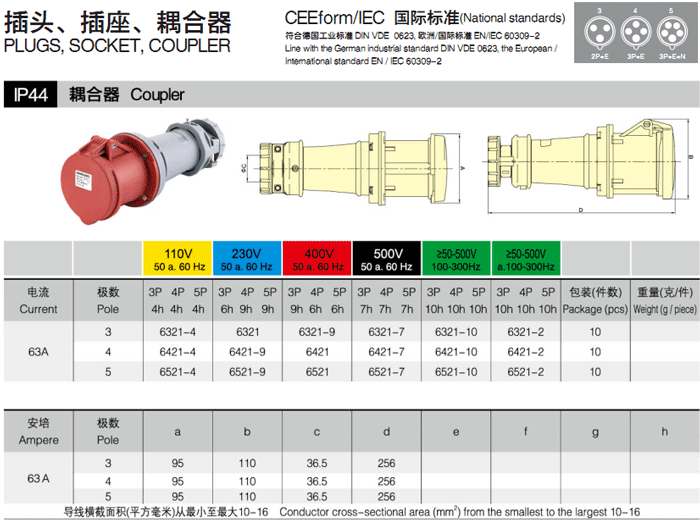
Industrial and multiphase power plugs and sockets
From Wikipedia, the free encyclopedia
Jump to:
navigation, search
Pin and sleeve connectors
Industrial and multiphase plugs and sockets provide a connection to the electrical mains rated at higher voltages and currents than household plugs and sockets. They are generally used in polyphase systems, with high currents, or when protection from environmental hazards is required. Industrial outlets may have weatherproof covers, waterproofing sleeves, or may be interlocked with a switch to prevent accidental disconnection of an energized plug. Some types of connectors are approved for hazardous areas such as coal mines or petrochemical plants, where flammable gas may be present.
Almost all three-phase power plugs have an earth (ground) connection, but may not have a neutral because three-phase loads such as motors do not need the neutral. Such plugs have only four prongs (earth, and the three phases). An example of a socket with neutral is the L21-30 (30 A) and the L21-20 (20 A) both of which have five pins (earth, neutral, and X, Y, Z phases).
While some forms of power plugs and sockets are set by international standards, countries may have their own different standards and regulations. For example, the colour-coding of wires may not be the same as for small mains plugs.
Contents
[hide]
1 Europe
1.1 Europe-wide IEC 60309 system
1.1.1 Entertainment industry
1.1.2 UK: Lewden plugs
1.1.3 Sweden, Germany & Netherlands: Perilex plugs
1.1.4 Croatia, Serbia, BiH, Slovenia, Montenegro, Macedonia
2 North America
2.1 Pin and sleeve
2.2 NEMA connectors
2.2.1 NEMA 10-20, 10-30 and 10-50
2.2.2 NEMA 14
2.2.3 Twist-locking connectors
2.3 Stage pin connectors
3 Australia and New Zealand
4 See also
5 References
[edit] Europe
32 A 400 V 3P+N+E
16 A 2P+E 230 V plug
Mated 16 A plug and wall-mounted socket
[edit] Europe-wide IEC 60309 system
Main article: IEC 60309
In Europe, the most common range of heavy commercial and industrial plugs are made to IEC 60309 (formerly IEC 309) and various standards based on it (including BS 4343 and BS EN 60309-2). These are often referred to in the UK as CEE industrial, CEEform or simply CEE plugs, or as "Commando connectors" (after the MK Commando brand name for these connectors).
Plugs are available in 2P+E (single phase), 3P+E (3 phase without neutral), and 3P+N+E (three phase with neutral). Current ratings available are 16 A, 32 A, 63 A, 125 A and 200 A.
Voltage and other characteristics are represented by a colour code (in three-phase plugs the stated voltage is the phase-phase voltage, not the phase-neutral voltage). The different voltages have the earth pin of a larger diameter than the others, and located in different places depending on the voltage rating, making it impossible to mate, for instance, a blue plug with a yellow socket. Since the different current ratings have different overall sizes, it is also not possible to mate different pin configurations or current ratings. For example, a 16 A 3P+E 400 V plug will not mate with a 16 A 3P+N+E 400 V socket and a 16 A 2P+E 230 V plug will not mate with a 32 A 2P+E 230 V socket.
CharacteristicColour
20–25 VPurple
40–50 VWhite
100–130 VYellow
200–250 VBlue
380–480 VRed
500–690 VBlack
>60–500 HzGreen
None of the aboveGrey
Yellow 2P+E, blue 2P+E, yellow 3P+E, red 3P+E, and red 3P+N+E are by far the most common arrangements. Blue 2P+E sockets (generally 16 A, although 32 A is becoming more common) are used as standard by British and Danish campsites and yacht marinas to provide 240-volt domestic mains power to frame-tents, trailer-tents, caravans, and boats; they are also used elsewhere in Europe for the same purpose, though in some countries the local domestic plug is also widely used. Static caravans generally use the similar 32-amp version because of the requirement to power electrical cooking and heating appliances. The blue 2P+E 16-amp version carrying 240-volts is also used in shopping malls and their peripherals to power 'temporary' stalls not incorporated within a lock-up shop, there is also use in domestic gardens within Britain to power garden equipment, barbecues, and temporary lighting. The yellow 2P+E 16-amp version carrying 115-volts is used extensively on the London Underground railway system to power temporary usage of heavy-duty fans; it is also frequently used by tradesmen within the UK, built-in to a portable transformer box that is powered from a standard 13-amp 240-volt mains supply, to run heavy-duty power-tools designed to operate at 115-volts. The red (3P+N+E) three-phase connector is frequently found in domestic and small farm situations in Britain where a wine press is used.
A small number of marinas provide 230 V single-phase power through a red three-phase connector (breaking the relevant standards in the process). This goes some way to ensuring that only boats that have paid the required fee (and thus obtained an appropriately made-up adaptor cable) are able to use the electricity.
[edit] Entertainment industry
Throughout Europe one of the common uses of industrial power connectors is in the entertainment and broadcast industries, where there is a need for vast amounts of power, delivered through quickly pluggable and unpluggable connectors.
In this industry they are referred to as Ceeform connectors. 230 V single-phase (blue) and 400 V three-phase (red) connectors between 16 A and 125 A ratings are used.
Where more current carrying capacity is required, such as between generator sets and distribution boards, VEAM Powerlocks or Camlocks are the choice. These connectors are single pole so five are required for a 3PH+N+E supply. Powerlocks have a rating of 400 A or 660 A at 1 kV. Camlocks E1016 Series are rated at 600 V 315 A.
Powerlocks are identified with the European harmonised colour code, they are also annotated as follows:
Brown, L1
Black, L2
Grey, L3
Blue, N
Green, Earth
Camlocks are also available in these colours.
Three phase plug ex. Yugoslavia
Three phase socket ex. Yugoslavia
[edit] UK: Lewden plugs
Lewden plugs and sockets are metal bodied waterproof plugs and sockets made by Lewden. The pin arrangements of the smaller single phase varieties are the same as BS 1363 and BS 546 plugs and sockets. These plugs and sockets will mate with normal plugs and sockets of the same pin arrangement but they are only waterproof when a Lewden plug is used in a Lewden socket and the screw ring is properly tightened (sockets have a metal cover that screws on to waterproof them when not in use).
[edit] Sweden, Germany & Netherlands: Perilex plugs
Main article: Perilex
Perilex plugs and sockets are 5-pin 3-phase connectors. The system provides 400 V 3P+N+PE and exists in 16 A and 25 A versions. In Sweden, the 16 A is generally used for stoves and to some extent for other heating devices in kitchens.
[edit] Croatia, Serbia, BiH, Slovenia, Montenegro, Macedonia
This type of three phase plug and sockets are mainly used in ex. Yugoslavian countries, they are 5-pin 3-phase connectors, rated at 16A, 380V.
[edit] North America
[edit] Pin and sleeve
Pin and sleeve plug
Pin and Sleeve circular connectors are not compatible with the newer IEC 309 type. Current ratings are 30, 60, 100, 200, and 400 A. All are rated for voltages up to 250 V DC or 600 V AC. Contact arrangements are from 2 to 4 pins. There are two styles depending on the treatment of the ground. Style 1 grounds only on the shell. Style 2 uses one of the contacts as well as the shell, internally connected together. They are not strongly typed for specific circuits and voltages as the IEC 309 are. One insert rotation option is available to prevent mating of similar connectors with different voltages.
The contacts in the plug are simple cylinders (sleeves), while the pin contacts in the receptacle have the spring arrangement to hold contact pressure, the reverse of the IEC 309 type connectors. All contacts are the same diameter. Originally metal construction was used, but now they are also made with plastic shells. Since only keying in the connector shell is used, and since the keys can be damaged in industrial use, it is possible to mis-match worn connectors.
[edit] NEMA connectors
Main article: NEMA connector
NEMA devices are not exclusively industrial devices, and some types are found in nearly all buildings in the United States. Many of these standards are identical to their counterparts in Canada, although there are some exceptions. NEMA wiring devices are made in current ratings from 15–60 A, and voltage ratings from 125–600 V.
There are two basic classifications of NEMA device: straight-blade and locking. The locking type is found mostly in industrial applications. Numbers prefixed by L are twistlock, others are straight blade.
[edit] NEMA 10-20, 10-30 and 10-50
NEMA 10-30
NEMA 10 devices are a curious throwback to an earlier time. They are classified as 125/250 V non-grounding, yet they are usually used in a manner that effectively grounds the appliance, albeit not in a manner consistent with most modern practice.
As commonly used, 10-30 and 10-50 plugs have the frame of the appliance grounded through the neutral pin. This was a legal grounding method under the National Electrical Code for electric ranges and electric clothes dryers from the 1947 to the 1996 edition. Since North American dryers and ranges have certain parts (timers, lights, fans, etc.) that run on 120 V, this means that the wire used for grounding is also carrying current. Although this is contrary to modern grounding practice, such installations remain extremely common in the United States and are relatively safe, because the larger conductors used are less likely to be broken than the smaller conductors used in ordinary appliance cords.
Persons moving their older appliances to newer NEMA 14-equipped buildings (or vice-versa) should have the cords replaced by a qualified electrician, as the grounding details may be quite confusing to the uninitiated.
NEMA 10-20 devices are very rare nowadays. There is also a similar obsolete design, lacking a NEMA configuration number, rated 125 V 15 A or 250 V 10 A which is nearly identical to the AS/NZS 3112 standard used in Australia/New Zealand. These are also extremely rare.
[edit] NEMA 14
NEMA 14-30 and 14-50 receptacles
The NEMA 14 devices are 4-wire grounding devices available in ratings of 15–60 A. Of the straight-blade NEMA 14 devices, only the 14-30 and 14-50 are common. The voltage rating is a design maximum of 125/250 V. They are essentially the replacements for the connectors above with the addition of a separate grounding connection.
All NEMA 14 devices offer two hots, a neutral and a ground, allowing for both 120 V and 240 V (or 120 V and 208 V if the supply system is three phase wye rather than split phase or three phase center tapped delta) appliances. They differ in rating and shape of the neutral pin. The 14-30 has a rating of 30 A and an L-shaped neutral pin. The 14-50 has a rating of 50 A and a straight neutral pin sized so that it will not fit in the slot of a 14-30.
NEMA 14-30 devices are most commonly found serving electrically-heated clothes dryers, while 14-50 devices most commonly serve kitchen ranges. In the United States, these are generally found in buildings constructed after the 1996 National Electrical Code, although they are also found in considerably earlier mobile homes. In Canada, the use of NEMA 10 devices was discontinued much earlier (if it was ever permitted at all), so NEMA 14 devices are more common there.
[edit] Twist-locking connectors
30 A 208Y/120 V socket L21-30 Plug and receptacle
L21-30 Plug.
Twist-locking connectors were first invented by Harvey Hubbell III in 1938 and Twist-Lock remains a registered trademark of Hubbell Incorporated to this day,[1] although the term tends to be used generically to refer to NEMA twist-locking connectors manufactured by any company. Unlike non-locking connectors, twist-locking connectors all use curved blades that have shapes that conform to portions of the circumference of a circle. Once pushed into the receptacle, the plug is twisted and its now-rotated prongs latch into the receptacle. To unlatch the plug, the rotation is reversed. The locking coupling makes for a very reliable connection in commercial and industrial settings.
Like non-locking connectors, these come in a variety of standardized configurations and follow the same general naming scheme except that they all begin with an L for locking. Once again, the connector families are designed so that 120 V connectors, 208/240 V connectors, and various other, higher-voltage connectors can not be accidentally intermated.[2]
[edit] Stage pin connectors
A stage pin connector. Note the GR denoting the longer ground pin, which is not quite in the center to prevent the plug being inserted upside down
A stage pin connector (SPC), or grounded stage pin (GSP), is a connector used primarily in the theatre industry for stage lighting applications in the United States. Stage pin connectors are generally used for conducting dimmed power from a dimmer to stage lighting instruments, although occasionally they can power other equipment.
The primary advantage of the stage pin connector over the NEMA 5-15 connector (commonly known as an Edison connector in the theatre industry) is its increased durability and resistance to damage due to its more robust construction and the ability to compensate for wear with a pin splitter. Having a distinct connector designated for dimmable power also helps prevent confusion of dimmed and non-dimmed circuits which could lead to equipment damage. Even the smallest stage pin connectors are rated for 20 A, which translates to 2.4 kW at 120 V, compared to the 15 A and 1.8 kW of the NEMA 5-15. In applications where cables are on the floor, the low profile of the connector allows for connections that are only slightly higher than the cables they connect.
[edit] Australia and New Zealand
Australian 3-phase socket outlet, rated at 20 A, IP56. Single-phase Australian socket outlets are seen in the background.
In Australia, New Zealand and some pacific islands, a different standard is used. The plugs and sockets are manufactured by Clipsal (Australia) and PDL (New Zealand) respectively. The most common is arguably the 32 A version of the Clipsal 56 series, named after its IP 56 rating. Also available are metal-clad and the 66 series and some European CEE standard outlets. The 56 series only allows metal-clad housings for 50 A and above, while the 66 series allows plastic housings with interlocks (cannot mate or separate some interlocking plugs with the power on) however it has a different pin configuration (AS3123).
Multiple pin version are available, 3 pins for single phase in 10, 20 and 32 A, 4 pins for 3 phase motors that do not require neutral connection in 10, 20, 32, 40, 50 and 60 A and 5 pins for equipment and distribution boards that require neutral and earth. 6 and 7 pin versions are also available in 10 and 20 A in 56 series and 50, 63 and 80 A in 66 series with extra control pins. Since neutral is the central pin, 4 pin plugs will fit 5 pin sockets, but the same does not hold for 3 pin plugs. While all residential Australian sockets will accept plugs of a lower rating, apparently only 32, 40 and 50 A industrial sockets of the same series will accept plugs of lower,...............www.everfarelec.com
